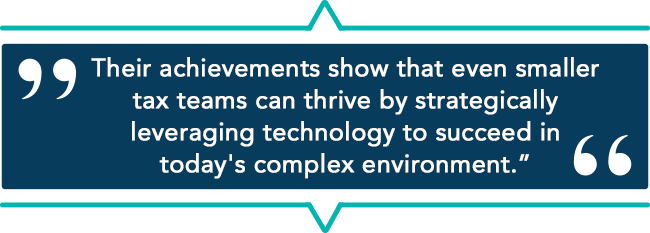We recently sat down with corporate tax experts Eric Williams and Carter Butler to look at a few tax world challenges and why tax technology is essential to meet them. Check out their insights as they discuss tech’s ability to help tax professionals navigate complex regulations, ensure compliance, and drive more efficient operations in today’s era of rapid transformation.

Can you share a current change causing challenges for tax teams?
Eric: The first thing that comes to mind is the FASB’s release of ASU 2023-9, which finalizes rules for income tax disclosures. The new rules focus on rate reconciliations which previously lacked consistency. They also mandate detailed breakdowns to enhance clarity for investors when interpreting financial statements. Companies are now required to manage much more data than before, which can strain resources. And this shift aligns with even broader new tax trends that require extra work, such as Pillar Two calculations and potential public data filings.
The FASB example is a good one for two reasons. Taxpayers must develop a process to meet the requirements, and it encapsulates a few common challenges that need to be addressed to stay ahead in the current tax climate:
- Complexity: Tax is more complex than ever before, thanks to BEPS, Pillar Two, Income Tax Disclosures, the CARES Act, and TCJA.
- Transparency requirements: There’s a push for more transparency in tax, with taxing authorities, investors, and stakeholders wanting more granular and real-time data.
- Big data: The amount of data we’re dealing with is growing exponentially. While this brings opportunities, it also means more work managing and processing that data to make it useful.
- Visibility to tax: Tax departments are seen as strategic partners today. This brings a sense of importance but also more scrutiny and pressure to deliver valuable input.
- Resource constraints: Baby boomers are retiring—and it’s harder to hire and retain top talent. This is due to fewer accounting graduates, a growing need for people who also have technological skills, and people staying in jobs for shorter timeframes today.
How can tax teams get their arms around all that without adding resources?

Carter: First of all, if you’re feeling overwhelmed trying to keep up and manage your team, you’re not alone. With so much happening, the key question is: how do we continue to deliver effectively? The answer isn’t simply to work longer hours. Let’s talk about a few key steps tax departments should consider to meet today’s pressures.
To draw a parallel outside of tax, I’ll point to Tom Brady. In college, Brady went largely unnoticed and struggled to get on the field at times. He was selected in the 2000 NFL draft with the 199th pick. Did Brady go from a college backup player to an all-time great on his own overnight? Or, did New England’s environment, culture, and strategy help him unleash his potential? More likely, the latter. Similarly, in tax, there are a few all-important decisions we make that cultivate the right environment and give us a strategy to manage an ever-growing workload with great success.
- First, implement tax technology, it’s a true game changer. For example, when your software is constantly updated to reflect the latest tax changes, your job is simplified, and you can put time savings toward other value-adding activities.
- Second, own your data. To manage tax risks and minimize surprises, it’s imperative we understand and contextualize our data. This helps us and the rest of the organization stay informed. Further, maintaining data in-house allows you to align tax strategy and risk tolerance with the organization’s overall strategy and appetite for risk.
- Third—and equally important—prioritize people. Good people are hard to find, especially in tax. Create an environment focused on automation and future-preparedness to help retain talent and ease transitions when people leave.
Diving deeper into tax technology, with Corptax, you get centralization—having data, processes, calculations, and reporting in one place. With centralized data, guided by our tax law experts embedding current tax law, your processes become streamlined and efficient. This unified approach not only helps you manage current changes in regulations but lays a strong foundation for future adaptability.
Eric: Let’s also talk about scalability in your tax environment. Scalability is about more than handling greater volume; it’s about delivering on new requirements like Pillar Two. Scalability ensures that as your business evolves, your tax processes can seamlessly expand and adjust without compromising accuracy or efficiency. Scalability also makes it much simpler to adapt to change fluidly. And it’s easier to customize how you process, analyze, and present data to meet the various needs of internal and external stakeholders.
Two other benefits tax technology brings are structure and transparency. With increasing demands for transparency by auditors, you need complete visibility to all data at all levels—and the ability to develop fast audit support. For instance, with Pillar Two, you need to leverage data for compliance, provision, and CbC to meet new reporting requirements. Effectively accessing, using, and aggregating your data facilitates accurate deliverables. A solid data structure helps reconcile different data sets and simplifies addressing audit questions.
Carter: This is also important because under-resourced tax teams are more susceptible to audit issues and higher penalties. The IRS plans to triple audit rates in the next three years. A structured database allows you to focus on unaudited areas, assess risks, and adopt a risk-based approach. It also drives big efficiencies, easing workloads. Maintaining continuity is crucial in tax departments and relies on robust processes. With higher turnover today, having strong, technology-based processes ensures a standardized approach that transcends staff fluctuations. Standardized processes keep work moving, and they help new team members get up to speed quickly.

And finally, mobility comes into play. Tax teams are constantly on the move and spread across the globe. For international provisions, for example, obtaining data from foreign controllers, who are preoccupied with their own tasks, can be challenging. Technology can streamline this process by centralizing needed information and making it available to all who need it, ensuring a successful close.
Can you share a couple of examples of tax tech conquering a compliance or provision challenge?
Eric: Sure, let’s start with Form 4626. It has expanded from two to seven pages and involves complex interactions with other forms, such as Form 5471.
This year, when the final form was released, it required three years of data to determine applicability. Our Corptax system handles these connections seamlessly and makes this data readily available. It also provides structure, flexibility, and real-time updates—majorly accelerating what would otherwise be a tedious, time-consuming process.
Example two is FASB’s release of ASU 2023-09 and its rigorous disclosure requirements mentioned above. Technology enables transparency to the right levels of detail. Additionally, it makes it easier to group line items and understand mandatory thresholds.
Tax technology is a good fit for large tax teams, but how about smaller tax teams?
Carter: Excellence is subjective and looks different for every tax team. Take the Curran Group, for example, based in Illinois. Their two-person tax team handles nearly 400 filings across the US. Their goal was to achieve incredible efficiency and as much automation as possible to get home before dark during Chicago winters. Curran Group saves 200 hours annually by automating with our tools, such as pulling adjustments directly from Corptax. They’ve streamlined their compliance across 50 states and uncovered significant tax savings with just 30 minutes of analysis—a task that used to take 25 hours. Their successes show that even smaller tax teams can thrive by strategically leveraging technology to achieve efficiency and effectiveness in today’s complex environment.
Any final thoughts?
Eric: The evolving tax landscape, shaped by new regulations like FASB’s updated income tax disclosures, brings both challenges and opportunities. From dealing with BEPS, Pillar Two, and other reforms to managing talent and processes effectively, tax technology is a must. Whether you’re a large tax team or a small one, you’ll streamline operations, ensure compliance, plan strategically, and build a culture that’s ready for the future.
View the webinar to learn how tax teams identify the right technology for their needs
about this topicAbout Eric Williams
A thought leader and industry contributor, CSC Corptax® Director Eric Williams regularly speaks at the Tax Executives Institute (TEI) and ACT’s Annual Technology Conference. He specializes in international compliance and ASC 740. Eric is a licensed CPA and holds both a Master of Science and a Bachelor of Business Administration in Accounting from Texas A&M University.
About Carter Butler
As the Product Marketing Manager at CSC Corptax®, Carter Butler is a liaison between tax professionals and internal Corptax teams. He empowers tax teams to optimize their processes with innovative tools that streamline daily tasks and enhance work-life balance. A former tax professional with PricewaterhouseCoopers LLP, Carter used Corptax solutions every day. He is a licensed CPA and holds an M.S. in Accounting from the University of New Hampshire.
